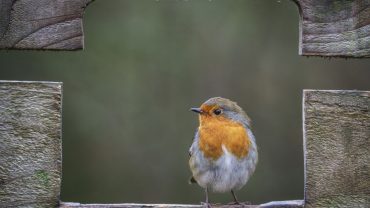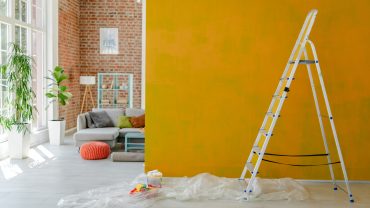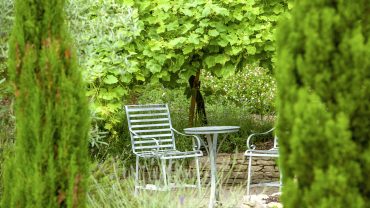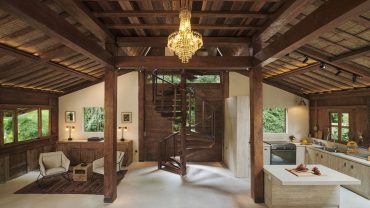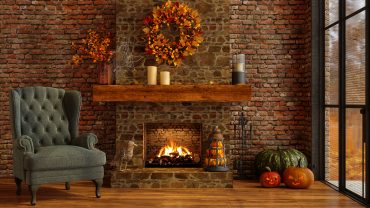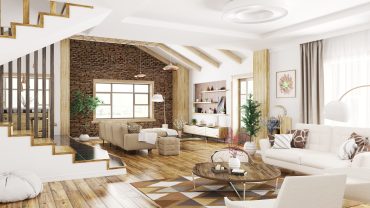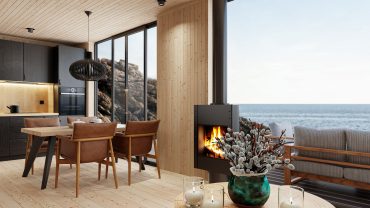Inspired by the country manors of 18th century France, French provincial interior design is a unique mix of natural elements and Baroque opulence, all with a rustic edge. Popularised as an architectural style in the US after World War I, it has since evolved to include interiors, celebrated for creating spaces that are both comfortable and refined.
So, what defines the French provincial interior design style? That’s what we’re finding out. Ready? L’escar “go.”
Origins of French Provincial Decor

Moliere and Louis XIV at breakfast in the Palace of Versailles (Credit: pictore via Getty Images)
The French provincial interior design style has its roots in the 17th and 18th century manor houses of rural France. Their designs were inspired by the Baroque and Rococo styles so fashionable in Paris at the time; those exemplified in King Louis XIV’s Palace of Versailles. Artisans outside the major cities began to emulate the ornate furnishings and decorative elements of the aristocracy, but used locally available materials and simpler techniques. This led to the development of a distinct style that balanced elegance with practicality.
In the 1920s, this French provincial style gained fresh popularity in the US, with architect Frank J. Forster leading the charge. Eventually, what started as an architectural style was mirrored indoors in French provincial house interiors. Let’s look at some of its defining features.
Key Characteristics of French Provincial Design

Classic French Provincial interior design (Credit: Andreas von Einsiedel via Getty Images)
French provincial interior design is defined by several hallmark features that together create its signature look and feel. From the muted colour palettes to the use of natural materials, each element contributes to the overall ambience of warmth and elegance. Here’s a closer look at the key characteristics that make French provincial decor so distinctive.
A Muted Colour Palette
The colour scheme in French provincial home decor typically features soft, muted hues inspired by the natural surroundings of the French countryside. Creamy whites, gentle blues, warm yellows, and earthy tones are commonly used. These colours contribute to a serene atmosphere and serve as a neutral backdrop for other design elements. Occasional splashes of richer colours like deep reds or greens may be incorporated to add depth and interest.
Natural Materials & Textures
Natural materials play a crucial role in achieving the authentic feel of French provincial house interiors. Exposed wooden beams, stone walls, and terracotta tiles are architectural features often found in such interiors. Wooden furniture is usually crafted from oak, walnut, or cherry and may display signs of distressing or weathering to enhance the rustic appeal. Linen and cotton fabrics are preferred for upholstery and window treatments, offering both comfort and durability.
Meanwhile, textures are layered to add visual interest. For example, a rough-hewn wooden table might be paired with delicate lace tablecloths or embroidered linens. Wrought iron elements, such as curtain rods or light fixtures, introduce an additional textural contrast and echo the craftsmanship of provincial artisans.
Furniture with Function & Form
Furniture in French provincial interiors combines elegance with simplicity. Pieces often feature curved lines, cabriole legs, and subtle carvings that reflect the influence of Rococo design but are less ornate. Armoires, buffets, and farmhouse tables are staple items, providing both functionality and style. Painted finishes in muted colours or natural wood tones are common, sometimes with a distressed look to convey a sense of history.
Upholstered chairs and sofas in French provincial home decor prioritise comfort and are typically adorned with cushions and throws. Toile de Jouy fabric, featuring pastoral scenes or floral patterns, is a popular choice for upholstery and adds a quintessential French touch to the décor.
Traditional Decor
Accessories and decorative items in French provincial interior design are thoughtfully selected to enhance the overall aesthetic without overwhelming the space. Ceramics, such as urns and vases, often display traditional patterns and are used to showcase fresh flowers or greenery. Mirrors with ornate frames can amplify natural light and contribute to the sense of openness.
Artwork and wall décor may include pastoral paintings, antique clocks, or wrought iron sconces. Layered window treatments with lace curtains and heavier drapes provide both privacy and a touch of elegance. Attention to detail is evident in the use of decorative mouldings, embellished hardware, and other subtle accents that unify the design.
Influence on Modern Interior Design

Contemporary and classic French Provincial design elements (Credit: moodboard via Getty Images)
French provincial interior design continues to inspire contemporary decorators and homeowners seeking a balance between elegance and comfort. Its emphasis on natural materials, neutral colour palettes, and timeless furniture pieces aligns well with modern preferences for sustainable and versatile design. The style’s adaptability allows it to blend seamlessly with other aesthetics, such as farmhouse or shabby chic, creating spaces that are both functional and aesthetically pleasing.
The Maison, Sweet Maison Style of French Provincial Design

18thC French Provincial interior design (Credit: simonbradfield via Getty Images)
As we’ve seen, French provincial interior design represents a muted version of the grandeur of the 17th and 18th century French court. In combining a muted colour palette, natural materials, and elegantly simple furniture, French provincial home decor aims to create inviting spaces that are both comfortable and sophisticated.

